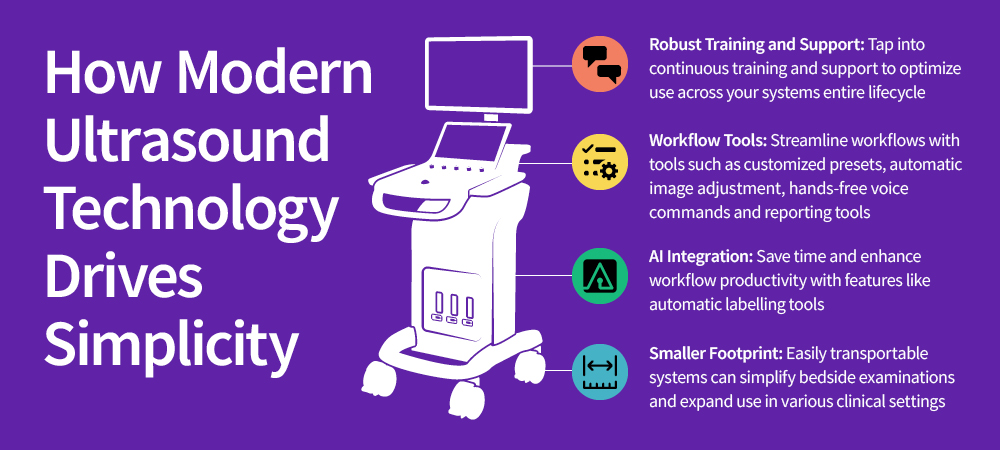Discover how the right primary care ultrasound system can increase patient satisfaction by reducing wait times and access barriers.
As a general practitioner, you are trained to do some amazing things, but bending time is not one of them. Even the most well-intentioned and well-oiled medical machines experience delays and lags that lead to increased patient wait times. The average patient waits nearly 20 minutes to see a doctor after arriving at the office, up 24% over the past 18 years.1 These delays can cause hasty, lower-quality patient treatment, provider burnout,2 increased morbidity and mortality,3 and lower patient satisfaction scores.4
One of the ways that you can work to reduce these wait times is by bringing more resources in-house, ensuring that the right diagnostic tools are on hand to expedite care and provide more robust and collaborative treatment. Continue below to learn how the right ultrasound system can help reduce patient wait times in your practice.
Reducing "guesswork" and referral delays
In the absence of adequate diagnostic resources, clinicians may be forced to conduct an initial "process of elimination Q&A" when patients present with abnormal (or even general) symptoms. This "back-and-forth" between patients, their providers, care team members, and even front-of-office staff can compound delays and grow the queue in the waiting room.
Even on a purely administrative level, outgoing patients can overwhelm the front office while navigating the referral process and coordinating out-of-office appointments. These incidents, seemingly a few minutes of delay here or there, can add up to produce hours of excess wait time for incoming patients.
One way to reduce administrative scheduling strain, as well as eliminate unnecessary delays, is the ability to use ultrasound in office. By bringing the procedure in-house, you may get to the heart of the diagnosis more quickly, reduce guesswork, and maximize efficiency.
The right tools: Leveraging technology for confident, expedited care and operability
The right primary care ultrasound system can serve as a versatile resource, offering the best tools for quickly and accurately performing scans, as well as facilitating efficiency in reporting, billing, and reimbursement. As a practice operating on a budget, you need and deserve equipment that does as much as possible, whenever possible, whether it's your ultrasound system, your X-ray machines, or your blood pressure monitors. Features such as easy portability, highly-reliable image quality, hands-free voice commanded operability and easy workflows help providers perform and access ultrasound scans quickly and easily.
Practices typically benefit from a simpler workflow and greater interoperability while expediting processes that previously required hours of manual effort. Look for primary care ultrasound equipment that offers intuitive features to help clinicians maximize scan accuracy and minimize time or duplication of efforts.
Ultrasound anywhere: Designing an optimal experience
When choosing an ultrasound unit, the time-saving value of ergonomics and a small footprint cannot be overstated. Quick and easy transport and sleek designs can free up valuable facility space and reduce the time your colleagues and patients spend waiting to get into a room. In addition, without a permanent ultrasound footprint in any single location, you can adjust office space requirements according to your daily caseload.
Some ultrasound options offer convenience and space-saving design across multiple product tiers, with many even offering portable options to help your practice maximize space and accommodate any size facility. Look for a system that offers ergonomic features that help you adjust positions simply and quickly.
Flattening the learning curve
The learning process of integrating new ultrasound systems and software can add extra hours to your team's work week, which translates directly to increased delays in the waiting room. Clinicians can spend valuable time learning new workflows on the fly or troubleshooting complicated operational issues.5 These "growing pains" impact all kinds of specialty areas, whether you're a small practice trying to serve an expanding cardiac population or looking to offer more in-office options for bladder or musculoskeletal patients.
It's important that your primary care ultrasound system accommodates all experience levels. An intuitive, user-friendly workflow can support novices and experts alike. One of the steepest learning curves for novice users is navigating the system parameters for image quality and anatomy optimization. System features such as the ability to create and set standardized protocols, automated image optimization and real-time reference information to help locate the desired scan plane can help providers improve image clarity and positioning while enabling users to quickly move through predefined or customized protocols with little or no manual adjustment or preparation.
Outside the office: Providing general access in more environments
In addition to decreasing patient wait times in the office, an in-house ultrasound could potentially improve patient outcomes by expediting care. In many parts of the world, patients may wait weeks at a time for an ultrasound scan because of insurance resources, a backlog of patient caseloads, and other factors. In the meantime, they could be facing a life-threatening health condition for which early—or even timely—detection could make a critical difference.6
Having an ultrasound at your disposal allows your practice to accelerate diagnosis and treatment of conditions, limit wait times throughout the care process, and provide quality care to more patients. As you look to scale up your practice and increase your scope of care, the right primary care ultrasound system can be a valuable tool in your arsenal by decreasing staff burnout and increasing patient satisfaction and engagement while offering reliable quality of care.
Reliable, affordable, easy-to-use and versatile, Versana ultrasound systems have a variety of automation features, intuitive controls, and budget-friendly options to best meet patient needs.
JB27758XX
REFERENCES:
1. Schibell N. Hurry up and wait: long wait times cripple access to care, health outcomes, and patient experience. Forrester. 2022. https://www.forrester.com/blogs/hurry-up-and-wait-long-wait-times-cripple-access-to-care-health-outcomes-and-patient-experience/#:~:text=The%20average%20patient%20appointment%20wait,door%2C%20it%27s%20another%2019%20minutes.
2. Marshall, E. G., Miller, L. J., & Moritz, L. (2023). Challenges and impacts from wait times for specialist care identified by primary care providers: Results from the MAAP study cross-sectional survey. Healthcare Management Forum, 36(5), 340–346. https://doi.org/10.1177/08404704231182671
3. Kharraz O. Long waits to see a doctor are a public health crisis. STAT. 2023, May 1. https://www.statnews.com/2023/05/02/doctor-appointment-wait-times-solutions/
4. NRC Health. 2021 consumer panel highlights the impact of wait times on NPS scores - NRC Health. 2022, October 4. https://nrchealth.com/2021-consumer-panel-highlights-the-impact-of-wait-times-on-nps-scores/#:~:text=Longer%20waits%20most%20negatively%20impact,particularly%20damning%20for%20virtual%20care.
5. Breunig M, Hanson AC, & Huckabee M. Learning curves for point-of-care ultrasound image acquisition for novice learners in a longitudinal curriculum. The Ultrasound Journal. 2023; 15(1). https://doi.org/10.1186/s13089-023-00329-2.
6. Aklilu S, Bain C, Bansil P, et al. (2021). Evaluation of diagnostic ultrasound use in a breast cancer detection strategy in Northern Peru. PLOS ONE. 2021;16(6): e0252902. https://doi.org/10.1371/journal.pone.0252902.


